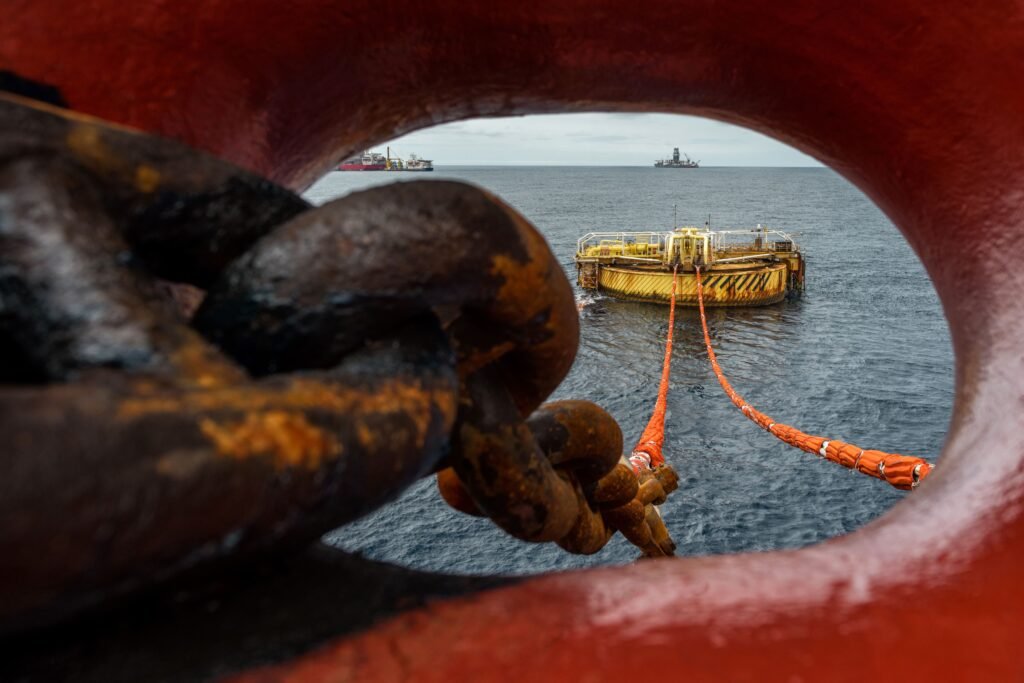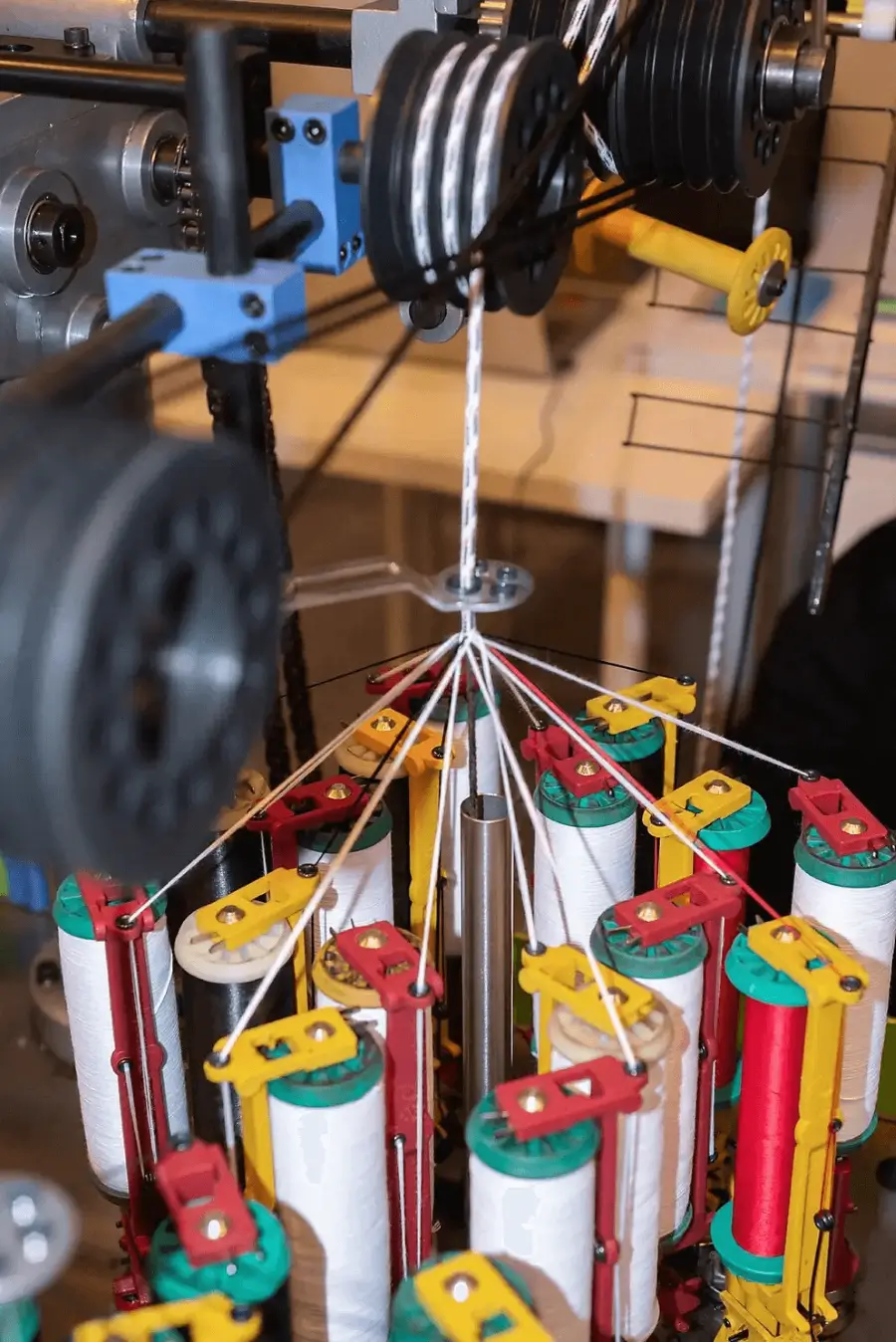Table of Contents
ToggleIntroduction
What is the best mooring line choice? This guide simplifies this critical choice; for instance, it covers HMPE mooring rope vs traditional types of mooring lines. All key performance differences are explored so you can make a protective decision for your vessel and crew’s safety.
Why Choose Between HMPE and Traditional Mooring Lines?

To understand what is a mooring, it is a structure that secures a vessel. A mooring rope is used to attach the vessel to this structure, so choosing the correct mooring lines is important for a ship’s safety.
There are many types of mooring systems; therefore, you can compare traditional types of mooring lines with modern ropes. For instance, an HMPE mooring rope is very strong, yet it is also lightweight. This choice impacts performance and ultimately guarantees reliability.
HMPE mooring rope VS Traditional Types of Mooring Lines – Choose Wisely!
Choosing a mooring rope is vital, for it can make or break marine work. This section explains the mooring meaning and also shows what does moored mean. You will know the best mooring ropes and the best rope for mooring lines to keep your moored ship safe.
Keeping the Vessel Safe
The mooring lines definition is about safety, so a moored vs docked vessel must be secure. A HMPE mooring rope is safe because it has low snapback. In contrast, traditional types of mooring lines like nylon can whip back. This is deadly, therefore for safety, you need the strongest mooring line.
Boosting Crew Efficiency
Lighter ropes help the crew; for example, they speed up the mooring process. HMPE lines weigh less than steel, so they are simpler to haul. You can use pre made mooring lines or personalized dock lines. Consequently, fewer hands are needed for the job. You can find these dock lines and mooring lines for sale. HMPE ropes make handling easy.
Operational Costs
An HMPE mooring rope review often notes cost savings. The first cost is high; however, they last a long time. You spend less in the long run since they do not need frequent repairs. Good mooring arrangement and layouts also help. Indeed, a planned mooring lines arrangement saves money.
MEG4 Compliance
Proper mooring lines for ships must meet safety rules, including MEG4 standards. Most HMPE mooring rope products pass these tests, and the right mooring lines sizes are key. For this reason, a mooring line size chart is necessary for ship mooring lines.
Long-Term Reliability
Picking the right type of mooring lines matters because there are many mooring line types. HMPE lines are reliable. They resist abrasion well; in addition, they resist chemicals. This gives them a longer life. They are good for a mooring system. This includes boat mooring systems as well as sailboat mooring systems.
Informed Decision
Make an informed choice, so think about mooring lines and their uses. Consider your boat’s weight and your budget. For rough seas, you may need heavy duty mooring lines for the task. Furthermore, you should know what are mooring lines in recovery. These mooring lines for recovery handle strong winds. Understanding mooring lines in recovery keeps your crew safe.
Analyzing Traditional Types of Mooring Lines!

When choosing a mooring line, the type of material matters. Each material has its own pros and cons. Knowing them helps you pick the right rope for your boat’s needs.
Nylon’s Stretchy Nature
Nylon rope is stretchy, so it soaks up sudden loads. This elasticity makes nylon lines act like a shock absorber, consequently putting less strain on hardware. For mooring, a twisted nylon rope or a three-strand nylon rope is a trusted choice. This nylon rope white untangles easily. Meanwhile, the braided nylon rope hides fewer frays. You can find nylon rope for sale at a good nylon rope price, but remember it weakens in sunlight.
Polyester Durability
Polyester is very durable, and it stretches less than nylon, which keeps your boat steady. The rope holds its strength when wet; additionally, it resists UV rays. A double braid construction adds protection, so many boaters use double braided polyester rope. The double braided rope is a worry-free choice. Brands like samson rope, Marlow Dockline, and New England ropes pre spliced dock lines have solid reputations.
Polypropylene Buoyancy
Polypropylene rope floats, so it is easy to see on the water. However, it is not as strong as nylon, and it breaks down in the sun. For these reasons, it is best for light-duty chores. For other needs, a braided nylon rope offers resilience. A solid braid rope or a solid braid nylon rope gives a firm grip. You can also use a nylon cord or a braided nylon cord for very light tasks.
Steel Strength
Steel wire ropes secure huge tankers because steel has amazing strength, which is perfect for giant ships. The wire hardly stretches; therefore, the ropes hold their position. On the other hand, steel ropes are heavy and stiff. They also rust without lubrication. The modern HMPE mooring rope is a better choice, as its double braided design is comfortable and flexible, yet it matches steel’s strength.
High Elongation
Some jobs need high elongation, and this is where traditional types of mooring lines like nylon shine. Nylon ropes have the most stretch, and that elasticity soaks up shocks. A double braided nylon rope offers strength and flexibility. This double braided nylon line handles changing loads with ease. For small boats, a 1 nylon rope works well. Larger tankers, however, need a 1 1 4 nylon rope or a 2 nylon rope.
Water Absorption
Water handling is important. For instance, nylon soaks up water and loses strength. Polyester and polypropylene keep water out, so they stay light. Steel wire rope does not absorb water, but it can rust. Then there is HMPE mooring rope, which is a favorite. It does not absorb any water; thus, it has the same strength whether wet or dry. The braided marine rope outperforms other lines in wet conditions.
| Feature | HMPE (UHMWPE) | Nylon (Polyamide) | Polyester | Polypropylene | Steel Wire |
| Specific Strength (kN·m/kg) | >3500 | ~1000 | ~1000 | ~650 | ~250 |
| Elongation @ Break (%) | 3-4 | 20-25 | 12-18 | 10-15 | <2 |
| Abrasion Resistance | Excellent | Good | Very Good | Poor | Good (contact) |
| UV Resistance | Excellent | Fair | Excellent | Poor | Immune |
| Specific Gravity | 0.97 (Floats) | 1.14 (Sinks) | 1.38 (Sinks) | 0.91 (Floats) | 7.85 (Sinks) |
| Strength Loss (Wet) | 0% | 10-15% | 0% | 0% | 0% (Corrodes) |
| Creep Resistance | Fair | Excellent | Excellent | Poor | Excellent |
Table on Analyzing Traditional Types of Mooring Lines!
HMPE vs Traditional Mooring Lines: Strength Comparison!
This comparison shows the strength benefits of modern mooring lines. Modern products outperform earlier generations and traditional types of mooring lines.
15x Steel
A high modulus polyethylene rope has great power and performance, so its strength-to-weight advantage stands out. The strongest rope material can outperform steel by fifteen times. This high tensile strength rope is a true high strength synthetic rope. These strong ropes define the upper limit for mooring technology.
43 cN/dtex
A Dyneema string measures up to 43 centinewtons per Decitex, which places it at the forefront of marine materials. Ship operators now rely on this engineered Dyneema cord when securing large commercial craft. This high tensile rope is better than generic Dyneema.
Highest Strength-To-Weight
The ultra-high molecular weight polyethylene rope core delivers the best rigidity. As a result, crews find the Dyneema rope easy to coil, splice, and haul. Understanding the difference in HMPE rope vs Dyneema ensures operators select the best strongest string for specific vessels. Duracordix’s HMPE mooring rope offers high performance and is easy for crews to handle.
1140 kN MBL
A 40-millimeter rope achieves a minimum-breaking load of 1140 kilonewtons, while a fitted Dyneema winch rope acts as an insurance policy for the crew and infrastructure.
Minimal Breakage
The anti-snapback rope design sharply curtails kinetic recoil. A fitted Dyneema line or Dyneema tow rope significantly reduces the hazardous energy from a snapped line.
Heavy Loads
Massive vessels can be secured, because the strongest rope is essential for high-demand mooring. The HMPE mooring rope is tailored to absorb the heaviest dynamic loads. Purpose-built fibers like Amsteel blue or Dyneema dm20 are essential for very large ships. The dm20 rope is built for offshore platforms.
| Feature | HMPE Rope | Polyester Rope | Nylon Rope | Polypropylene Rope | Steel Wire Rope |
| Relative Strength | 15x Steel | ~1.2x Steel | ~1.5x Steel | ~0.8x Steel | 1x (Baseline) |
| Weight (Density) | ~0.97 g/cm³ | ~1.38 g/cm³ | ~1.14 g/cm³ | ~0.91 g/cm³ | ~7.85 g/cm³ |
| Elongation | 3-5% | 10-15% | 20-40% | 15-25% | <1% |
| Abrasion Resistance | Excellent | Excellent | Good | Fair | Good (Chafe-prone) |
| UV Resistance | Excellent | Excellent | Good | Poor | N/A (Corrodes) |
| Handling & Safety | Lightweight, Low Snapback | Heavy, High Snapback Risk | High Elasticity, High Snapback | Lightweight, Easy Handle | Very Heavy, Fishhooks |
| Buoyancy | Floats | Sinks | Sinks | Floats | Sinks |
Table on HMPE vs Traditional Mooring Lines: Strength Comparison!
HMPE vs Traditional Mooring Lines: Weight Matters!

High Modulus Polyethylene (HMPE) ropes are changing vessel mooring. As these lines weigh less than traditional ropes, your crew can work more safely and keep the operation running smoothly.
Up to 85% Lighter
An HMPE mooring rope is made from ultralight polymers. This rope is 85% lighter than steel wire ropes. Your crew can work more safely. The lightweight advantage means crew members can lift the rope without risk.
7x Lighter
Beyond being light, HMPE has a great strength-to-weight ratio. It is 7x lighter than steel wire rope. traditional types of mooring lines are much heavier. This ease saves energy and also speeds up the mooring procedure.
Reduced Handling
The light feel of an HMPE rope changes how crews handle lines. Splicing is easy. Tying off to bollards is quick. Less effort means a lower risk of injuries, so your deck hands stay focused.
Fewer Personnel
HMPE mooring ropes are lighter than traditional cables, thus you don’t need as many hands. Fewer personnel are required. This means lower labor costs. This makes HMPE mooring ropes for sale an appealing choice.
Increased Efficiency
Lightweight lines speed up mooring. Duracordix’s lines lead to faster, safer, and smoother operations. Shorter mooring windows free up berth space. This is a powerful advantage when you compare the HMPE mooring rope price with savings.
Floats On Water
A perk of HMPE mooring rope for sale is its buoyancy. This floating rope for boats rides on the water’s surface. It will not sink or tangle. Recovery is quick. Our Duracordix HMPE mooring rope offers this security. Traditional types of mooring lines often sink.
How Does Elongation Differ in Mooring Ropes?
Mooring line stretch affects control and safety. This helps you select the right rope. Learn more below.
3-4% Elongation
An HMPE mooring rope has low stretch. Under load, it has an elongation of 3–4%. This keeps your vessel stable. A rope stopper mooring system, therefore, keeps the ship steady.
Low-Stretch Properties
Minimal elongation provides stability and prevents the vessel from moving forward or backward. This property provides excellent control.
Excellent Control
Low stretch gives you excellent control since the line has minimal elongation under load. It is perfect for spring line docking.
15-20% Elongation
Traditional types of mooring lines like nylon have more elasticity. A nylon rope can have an elongation between 15% and 20%, which makes tying a boat to a cleat easy.
Shock Absorption
High elasticity absorbs shock loads from waves and protects vessels from impacts.
Vessel Stability
Your choice of line affects vessel stability. Large vessels use HMPE mooring rope for its strength. However, smaller boats may use traditional types of mooring lines. Their flexibility is good for different knots for boating and for securing to a mooring harness.
| Feature | HMPE (UHMWPE) | Polyester (PET) | Nylon (Polyamide) | Polypropylene (PP) | Steel Wire |
| Strength-to-Weight | Exceptional | Good | Good | Fair | Poor (Heavy) |
| Tensile Strength | 30-43 cN/dtex | ~9.5 cN/dtex | ~9.5 cN/dtex | ~6.5 cN/dtex | High |
| Elongation @ Break | 3-5% (Very Low) | 12-15% (Low) | 18-25% (High) | 12-18% (Medium) | <3% (Very Low) |
| Abrasion Resistance | Excellent | Excellent | Good | Fair | Poor (Internal) |
| UV Resistance | Excellent | Excellent | Good (If Treated) | Poor | Excellent |
| Density (g/cmĀ³) | 0.97 (Floats) | 1.38 (Sinks) | 1.14 (Sinks) | 0.91 (Floats) | ~7.85 (Sinks) |
| Water Effect | None (Floats) | Minimal (Sinks) | Loses ~10% Strength | None (Floats) | Corrodes (Sinks) |
| Melting Point (Ā°C) | ~145Ā°C | ~260Ā°C | ~220Ā°C | ~165Ā°C | ~1400Ā°C |
Table on How Does Elongation Differ in Mooring Ropes?
Real Scenerios: Choosing the Right Mooring Line!

This part compares the uses of HMPE mooring rope with traditional types of mooring lines, offering tips to boost safety and speed up dock work.
LNG Carriers
The HMPE mooring rope is better than traditional types of mooring lines. A 24mm ship rope has high strength. Snap-back is less likely. Its low stretch stops ships from bouncing. It holds near a mooring buoy and boat cleats. This helps moor a boat. Light HMPE spares the mooring winch. It is the best boat rope for a mooring ball. So, what is a mooring ball? It is a float. You can find a mooring buoy for sale.
Offshore Platforms
HMPE mooring rope outlasts polyester sailing rope. A 40-mm marine rope holds 1140 kN. It locks to a mooring anchor or moorage buoy. HMPE resists UV and salt, unlike regular nautical rope. What does a mooring buoy look like? It is a float. You can see them with marine buoys for sale. The light line works with a winch and rope. Rigs stay put when a mooring pick up buoy drifts.
Container Ships
A 40mm mooring rope for boat has 1500 kN strength. It outlasts old sailboat lines. It is light. Crews use less energy. They haul it onto ship cleats. Its abrasion resistance guards mooring ropes for boats. The boat mooring lines chafe less on the dock. So, what is boat moorage? It is securing a boat. The rope slides easily over a rope cleat. This speeds up parking the boat.
Towing Operations
Towing needs strong lines like synthetic winch ropes. A 24mm HMPE braid is strong. It beats steel. A good tow rope is key. It has less stretch than nylon. Therefore, this gives more control. Marine cleats and the hawser take less wear. Smooth lines speed up ropes and rigging.
You need a good line for a water tow, a boat-to-boat tow rope, or a tow rope for truck. For boat tubing, a strong tow rope for tubing is vital. Use a reliable tube rope, boat tow rope, or towing tube rope. The boat tube rope and towable rope must be strong.
A good tubing rope and ropes for boat tubing use HMPE. The ski tow rope is similar. A tow rope for water ski must be safe. The tubing rope to connect everyone is important.
Large Vessels
A 40 mm steel mooring cable has less strength than an HMPE line. These cable mooring lines are strong. HMPE works with a wire rope thimble and stainless-steel shackles.
The ships mooring rope resists rust. Use it with stainless shackles, metal shackles, or steel shackles. You can also use a cable thimble, rope thimble, steel cable thimble, or wire thimble. The metal rope thimble is also an option. The light ship mooring rope is easy to handle near the stern of a ship.
Demanding Conditions
On stainless steel cleats, a 24 mm HMPE mooring rope is strong. It is the best marine rope. You can find stainless steel boat cleats and other boat cleats for sale. It outlasts polyester sailing lines in the sun. That is why people ask what type of rope to tie a boat. HMPE absorbs no water.
The mooring pendant stays tight. This is better than traditional types of mooring lines. Heavy-duty pop-up boat cleats and flat boat fenders work well. You can use pop up cleats or tie down cleats for boats.
Also use flat boat bumpers, dock piling bumpers, piling bumpers, and marine bumpers. Even nautical rope for crafts can be HMPE. Many stainless boat cleats are available.
Cost Analysis: HMPE Rope vs Traditional Lines!
This part examines the cost of choosing mooring lines. We break down the upfront pay, rope life, and care needs; consequently, you can see the total cost. This helps you choose the right line for your fleet.
Higher Initial Cost
HMPE mooring rope has a higher mooring line price than traditional types of mooring lines. The price comes from tough shaping and advanced materials.
Many buyers ask how much do ropes cost before they buy rope. A cheap rope like nylon looks good on paper, but the premium ropes tag on HMPE shows its value. If you want to know how much is rope, check a rope website.
Longer Lifespan
HMPE mooring rope lasts longer than standard lines. You will swap these ropes less often, so savings add up. Nylon may last five seasons, but HMPE can last twice that time; furthermore, it has a tough defense against abrasion, UV rays, and chemicals. When looking for strong rope for sale, remember this is not just about the mooring ropes price. This is better than some used ship rope for sale.
Less Maintenance
HMPE mooring rope needs less care than traditional types of mooring lines. Steel wire needs oil to fight rust. HMPE is a waterproof rope that will not corrode. The crew spends less time cleaning, and the boat spends less time out of service. This makes HMPE a smart pick when you order rope online. You can also find it from a rope supplier near me. When wondering where can I get rope, check a local rope shop near me.
Cost-Effective Solution
HMPE rope’s life-cycle cost is low despite a high initial price. It needs less maintenance and lasts far longer, so the initial outlay pays for itself. If you ask, “where can I buy rope that saves money?”, consider Duracordix. You can ask rope suppliers near me “how much does rope cost?” to get a clear analysis from a rope store near me.
Lower Replacement
HMPE rope’s ruggedness cuts down on restocking. Its strength means you will not be buying new rolls of rope often. Ships with HMPE can stretch the interval to ten years or more. This matters when you look for bulk rope near me or general rope for sale. Your rope purchase will be less frequent.
Better Bottom-Line
Choosing HMPE mooring rope improves your bottom line. These lines last longer and need less upkeep, so savings add up. The first rope purchase is money well spent. When looking for heavy duty rope or wondering where can I buy thick rope, ask rope manufacturers. Mooring rope manufacturers will explain the financial perks and tell you where to buy rope. If you need big rope for sale or even hemp rope near me, check for rope nearby.
The Future Trend is HMPE Mooring Rope!

Selecting the right rope is crucial for safety and efficiency. High Modulus Polyethylene (HMPE) ropes are the preferred choice for commercial mooring.
Bio-Circular Fiber
For carbon emission reductions, look to Dyneema® fiber from bio-circular feedstock. It is the world’s first bio-circular HMPE mooring rope fiber.
Industry Standard
These ropes are compliant with OCIMF MEG 4, SIRE 2.0, and SOLAS. MEG4, the industry standard, adopts a holistic view of a rope’s lifetime performance. Therefore, Dyneema® is the only fiber manufacturer to test and model the performance of both ropes and fibers.
Sustainable Materials
Compared to traditional types of mooring lines, UHMWPE ropes have a longer lifespan. This durability reduces frequent replacements and lowers labor costs.
Lower Carbon-Footprint
Dyneema® delivers the lowest carbon footprint per unit of strength. Additionally, faster mooring and reduced tug usage deliver a drop in the carbon footprint versus steel wire rope.
Innovative Technology
Unique coating and heat treatments provide excellent wear resistance. Heat Setting Procedures make ropes suitable for high-temperature environments. Some ropes utilize the Timm Snap Back Arrestor (SBA™) technology.
Proven Performance
With a 25-year record, ropes made with Dyneema® SK78 fiber offer security. They dramatically outperform generic HMPE lines with a longer, more cost-effective service life. We rigorously test both the fiber and the rope by simulating real-world conditions.
FAQs!
What Is MEG4’s 15:1 D/D Bend Ratio?
The mooring rope size guide from MEG4 is clear. Mooring ropes must not bend tighter than a 15-to-1 D/d curve, which means the bend’s diameter must be fifteen times the rope’s own mooring rope diameter. This ratio protects the fibers from getting crushed and also protects gear from jolts. Considering proper mooring ropes sizes is important.
How Does HMPE Rope Reduce Mooring Snapback Risk?
An HMPE mooring rope stretches very little under load, thereby storing less energy than traditional types of mooring lines like nylon or steel wire. It releases energy gently. This reduces the snapback hazard. A snapback is a dangerous mooring rope accident.
Compare Elongation: HMPE’s 4% Vs Nylon’s 20% – Difference?
The mooring rope definition includes its stretch. An HMPE mooring rope extends about 4 percent. This keeps the vessel stable. In contrast, nylon can stretch up to twenty percent. This stretch absorbs shock loads but reduces precision. Low elongation is key for safe mooring rope use.
Why Is HMPE Stronger Than Steel Wire?
So, what is mooring rope used for in demanding conditions? An HMPE mooring rope is the answer. HMPE fibers have long molecular chains. These chains transfer load effectively. Consequently, HMPE is 15 times stronger than steel at the same weight. It is also very lightweight, so crews can handle it easily.
What Determines A Mooring Line’s Service Life?
The mooring rope meaning includes its limited lifespan. A mooring rope inspection checklist tracks wear and stretch. Repeated bending also shortens a rope’s life. It is not a mooring rope crossword; the facts are clear. Both HMPE mooring rope and traditional types of mooring lines require following retirement rules.
Conclusion
HMPE ropes provide remarkable tensile strength. They are incredibly lightweight, and this enhances crew safety. Consequently, the line you pick affects overall operating costs.
When it comes to the HMPE mooring rope vs traditional types of mooring lines, HMPE is the superior alternative. A smart choice now means reliable, long-lasting service. For custom options and technical support, visit DURACORDIX.
About The Author
Moses Xu
Hi, I’m Moses Xu, VP and Marketing Director at Duracordix. With 10+ years in high-performance synthetic ropes and netting, I specialize in export trade and marketing. Whether it’s HMPE, Kevlar, or nylon ropes, I’m happy to share insights and connect!


